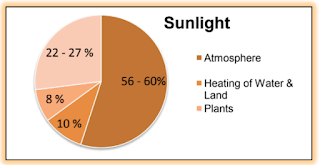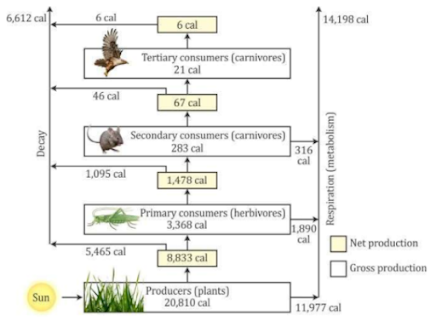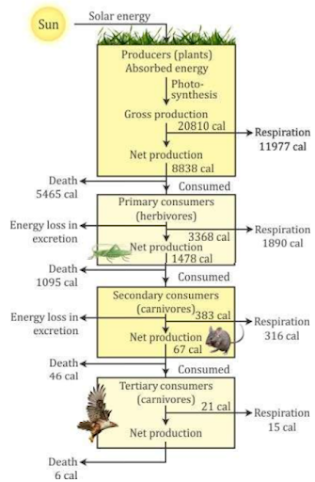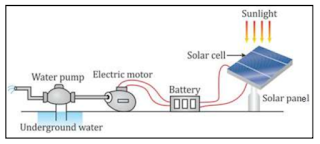ICSE Revision Notes for Heat and Energy Class 9 Physics
Chapter Name | Heat and Energy |
Topics Covered |
|
Related Study |
Concept of Heat
- Heat is a form of energy.
- Each object contains matter which is made of molecules. These molecules are in a constant state of motion. This gives them kinetic energy. Also, there is a force of attraction between the molecules. This gives them potential energy.
- Heat energy is the internal energy of these molecules. More the internal energy, hotter is the body.
- We can define heat as a form of energy that flows.
- The SI unit of heat is joule (J) and the CGS unit is erg.
- Calorie and kilo calorie are also units of heat.
1 kilo calorie = 1000 cal
Also, J and cal are related as:
1 cal = 4.186 J
Concept of Temperature
- The degree of the hotness of a body is determined by a quantity known as temperature.
- It also determines the direction of the flow of heat. Heat flows from a body at higher temperature to a body at lower temperature.
- The SI unit of temperature is kelvin (K). The other unit is degree celsius (°C). These two units are related as
T K = t° C + 273 - There is another unit of temperature called degree fahrenheit (°F). °F and °C are related as 9
T°F = 9/5 × t°C + 32
Thermal Expansion
- The expansion of a substance on heating is called thermal expansion of that substance.
- Solids have a definite shape. Thus, its length, area and volume, all increase on heating.
- The increase in length is called linear expansion, the increase in area is called superficial expansion and the increase in volume is called cubical expansion.
- Liquids and gases do not have definite shape, so they only have superficial and cubical expansion.
- Each substance is made up of molecules. When the substance is heated, the average kinetic energy of the molecules increases and they start moving faster.
- This increases the mean separation between the molecules, and hence, there is expansion in length, area or volume of the substance.
- On cooling, the average kinetic energy decreases, and hence, the mean separation also decreases. Thus, the substance contracts.
Anomalous Expansion of Water
- Substances expand on heating and contract on cooling. However, water, silver iodide and silica are exceptions. These substances contract on heating and expand on cooling within a specific range of temperature. This is called anomalous expansion.
- The expansion of water when it is cooled from 4°C to 0°C is known as the anomalous expansion of water.
- The variation of volume and density of water with temperature is shown below.
Hope’s Experiment
- The Hope’s apparatus demonstrating anomalous expansion of water was devised by T. C. Hope in 1805.
- The apparatus is shown below.
Consequences of Anomalous Expansion of Water
- Preserving of Aquatic Life in Very Cold Weather
- Bursting of Water Pipes, Plant Capillaries and Rocks
Energy Flow in an Ecosystem
- Energy is needed for all biological activities.
- The light from the Sun is used as follows:
- Plants absorb most of the light falling on them in the form of energy. Of this absorbed energy, only 0.02% is used in photosynthesis.
Food Chain
Energy Flow
Sources of Energy
- A source of energy is one which provides adequate amount of energy over a long period of time.
- A good source of energy would be one:
▪ which would do a large amount of work per unit volume or mass,
▪ which would be easy to transport from one place to another,
▪ which would be easily accessible, and
▪ which would be economical - The sources of energy can be classified into two forms:
▪ renewable or non-conventional sources of energy, and
▪ non-renewable or conventional sources of energy
Renewable or Non-Conventional Sources of Energy
- A natural source providing us energy continuously is called a renewable source of energy.
- These sources of energy can be used again and again and will never get exhausted. They are also called the non-conventional sources of energy.
1. Sun
- Sun is the most powerful source of radiation energy.
- The solar energy reaching unit area at outer edge of the Earth’s atmosphere exposed perpendicularly to rays of Sun at average distance between Earth and Sun is known as solar constant. Its value is approximately equal to 1.4 kJ per second per m2or 1.4 kW/m2.
2. Wind
- The large mass of flowing air is called wind. It possesses kinetic energy due to its motion and this energy is called wind energy.
3. Flowing water as source of energy:
- The kinetic energy possessed by flowing water is called hydro energy.
4. Biomass as source of energy:
- The wastes and dead parts of living beings like plants, trees and animals is called bio mass. They contain carbon compounds. The chemical energy stored in the bio mass is called bio energy.
- Bio gas is a mixture of gases produced during the decomposition of bio mass in the absence of oxygen. The main constituent of bio gas is methane (65%) and rest is a mixture of carbon dioxide, hydrogen and hydrogen sulphide.
5. Tides as source of energy:
- The energy possessed by rising and falling water in tides is known as tidal energy.
- Tidal energy is harnessed for producing electricity by constructing a dam across a narrow opening to the sea.
6. Oceans as source of energy:
- Ocean thermal energy: Water at the surface of an ocean gets heated by absorbing the heat of the Sun, while water at deeper levels of the ocean remains cold. The energy available due to this difference in temperature of water at the surface and at deeper levels of ocean is called the ocean thermal energy (OTE).
- Oceanic (or sea) waves energy: Due to the wind blowing on the surface of oceans, waves move at high speed on their surface, which are called oceanic waves or sea waves. The kinetic energy possessed by such fast moving oceanic (or sea) waves is called the oceanic (or sea) waves energy.
7. Geo thermal spots as source of energy
- At some places, rocks below the surface of Earth are very hot. Such places are called hot spots. The heat energy possessed by such rocks inside the Earth is called the geo thermal energy.
8. Nuclear fuel as source of energy
- In the processes of nuclear fusion and fission, the origin of energy is the mass defect between the reactants and products. This defect is converted into energy according to the Einstein's mass-energy equivalence relation E = mc2. This energy is called nuclear energy.
Non-Renewable or Conventional Sources of Energy
- The sources of energy which have accumulated in nature over a very long period and cannot be quickly replaced when exhausted are called non-renewable or conventional sources of energy.
The main sources of non-renewable energy are:
1. Coal
- Coal is a non-renewable substance made up of complex compounds of carbon, hydrogen and oxygen along with some free carbon and compounds of nitrogen and sulphur.
2. Petroleum
- Petroleum is a dark coloured viscous liquid also called crude oil. It is found under the Earth's crust trapped in rocks. It is called petroleum because petroleum means rock oil.
- It is a complex mixture of many hydrocarbons with water, salt, Earth particles and other compounds of carbon, oxygen, nitrogen and sulphur.
- The process of separating useful components from crude petroleum is called refining and it is done by fractional distillation.
4. Natural gas:
- Natural gas is found deep under the Earth's crust either alone or above the petroleum reservoirs.
- The main component of natural gas is methane (up to 95%) along with small quantities of ethane and propane.
Production of Electricity from Solar Energy
Solar Cell
The solar cells are usually made from semiconductors like silicon and gallium.
- If sunlight is incident on an impurity added semiconductor, a potential difference is produced between its surfaces.
- A single solar cell of area 4 cm2 produces a potential difference of nearly 0.4 V to 0·5 V due to which a current of nearly 60 mA can be obtained.
- An arrangement of solar cells is called a solar panel.
Advantages of using solar panels
- They do not require any maintenance.
- They last over a long period of time.
- Their running cost is almost zero.
- They are most suitable for remote, inaccessible, and isolated places where electric power lines cannot be laid.
- They do not cause any pollution in the environment.
Disadvantages of using solar panels
- The initial cost of a solar panel is sufficiently high.
- The efficiency of conversion of solar energy to electricity is low.
- A solar panel produces DC which cannot be directly used for many household purposes.
Solar Power Plant
- A solar power plant is a device in which heat energy of Sun is used to generate electricity.
Production of Electricity from Wind Energy
Production of Wind Energy through a Wind Generator
- When the wind strikes the blades of the wind mill, the kinetic energy of wind changes into rotational kinetic energy of the blades.
- The rotation of blades of the turbine rotates the armature of the dynamo. Due to the rotation of the armature in the magnetic field produced between the pole pieces N and S of a strong magnet, an alternating e.m.f. is produced between the terminals T1 and T2.
Advantages of using the wind energy
- It does not cause any kind of pollution.
- It is an everlasting source.
Limitations of using the wind energy:
- The wind farms can be established only at places near the coastal areas where wind blows around the year steadily with a speed not less than 15 km h-1.
- A large area of land is needed for the establishment of a wind farm.
- The establishment of a wind farm is expensive.
Production of Electricity from Hydro Energy
- The water at a height has potential energy stored in it. When this water falls down, its potential energy is converted to kinetic energy.
- The kinetic energy of water is transferred to the blades of turbine as the rotational kinetic energy.
- As the turbine rotates, it rotates the armature of the generator (or dynamo) in the magnetic field between the pole pieces N and S of a strong magnet due to which an alternating e.m.f. is produced between the terminals T1 and T2.
Advantages of using Hydro energy
- Hydroelectric energy is a renewable source of energy as the water on Earth will keep flowing for a very long time.
- Environmental pollution is not caused as the energy is obtained from flowing water.
- Construction of dams on rivers helps in controlling floods. It also aids irrigation process.
Limitations of using Hydro energy
- Dams can be constructed only in certain areas as flowing water is not available everywhere.
- Large areas of agricultural land and human settlement need to be sacrificed as they get submerged in the reservoir formed by dams.
- Large ecosystems are destroyed.
- The vegetation which is submerged, rots under anaerobic conditions and gives rise to large amounts of methane which is a green-house gas.
Production of Electricity from Nuclear Energy
- Nuclear energy is generated in a process called nuclear fission.
- In this process, the nucleus of a heavy atom when bombarded with low-energy neutrons splits into lighter nuclei. This releases a large amount of energy due to mass defect.
- The difference in mass m between the original nucleus and the product nuclei gets converted to energy E at a rate governed by Einstein’s equation E = m c2.
- The figure below shows a nuclear power plant in which the heat energy released due to the controlled chain reaction of nuclear fission of uranium-235 (or plutonium-239) in a nuclear reactor is absorbed by the coolant which then passes through the coils of a heat exchanger containing water.
- The water in the heat exchanger gets heated and converts into steam. This steam is used to rotate the turbine which in turn rotates the armature of a generator in a magnetic field, thereby producing electricity.
Advantages of using the nuclear energy
- A very small amount of nuclear fuel (such as uranium - 235) can produce a tremendous amount of energy.
- Once the nuclear fuel is loaded into a nuclear power plant, it continues to release energy for several years.
Limitation of using nuclear energy
- It is not a clean source of energy because very harmful nuclear radiations are produced in the processes which are highly energetic and penetrating.
- They cause ionisation and hence they are very harmful to the human body.
- The waste obtained from the nuclear power plants causes the environmental pollution.
Global Warming
- Global warming means an increase in the average effective temperature of Earth's surface due to an increase in the amount of green house gases in its atmosphere.
Greenhouse Effect
- The clouds and the green house gases prevent a large fraction of radiations given out by the earth's surface, from being escaped into the space.
- The green house gases present in the earth's atmosphere play a role similar to that of glass walls of a green house. Hence this phenomenon is called the green house effect.
- Thus, we define the green house effect as the phenomenon in which infrared radiations of long wavelength given out from the surface of a planet are absorbed by its atmospheric gases to keep the environment at the planet's surface and the lower atmosphere, warm.
Future Predictions
Observing some changes in the natural phenomenon at present, some future predictions can be made as follows:
- Dislocation and disappearance of plant and animal species
- Warming of the ocean
- Melting of glaciers
- Shift in the farming region
- Increase in new diseases and heat related deaths
- Changes in the regional climate
- Variable changes in the climate
- Increase in cost of air conditioning
- Change in the sea level
Ways to Minimise Global Warming
To minimise global warming, following three main measures must be taken:
- Technological measures
- Economic measures
- Policy measures













